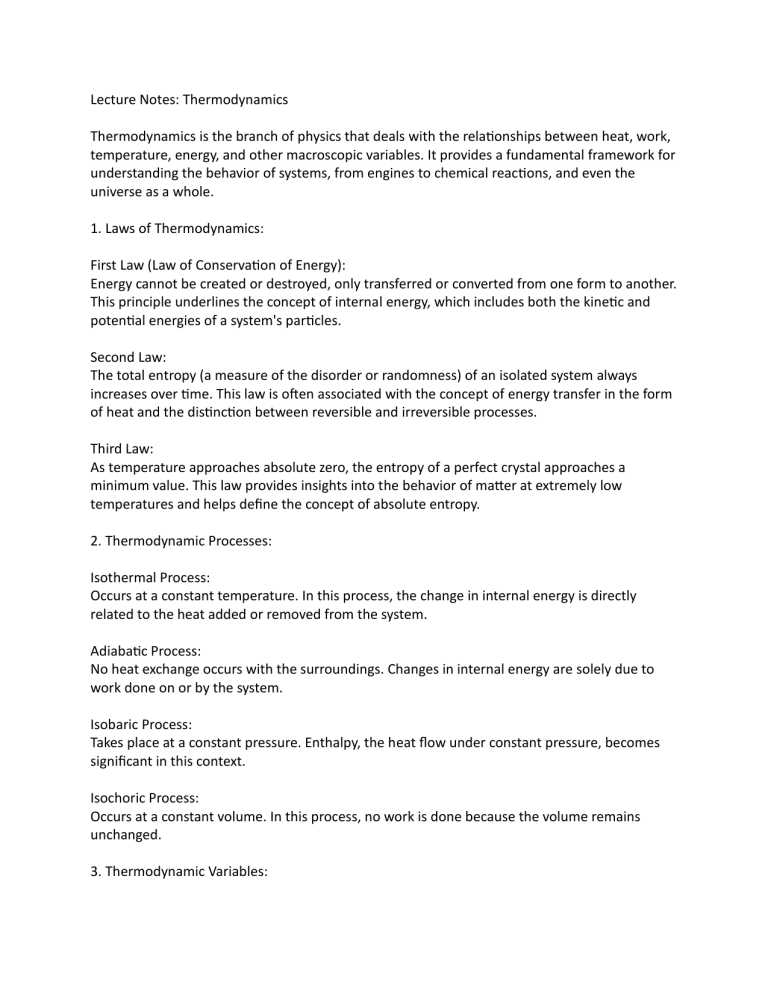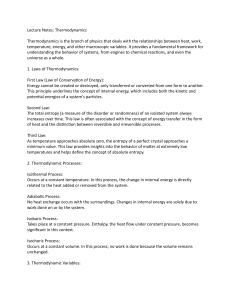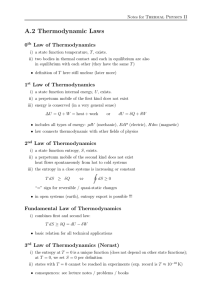
Lecture Notes: Thermodynamics Thermodynamics is the branch of physics that deals with the relationships between heat, work, temperature, energy, and other macroscopic variables. It provides a fundamental framework for understanding the behavior of systems, from engines to chemical reactions, and even the universe as a whole. 1. Laws of Thermodynamics: First Law (Law of Conservation of Energy): Energy cannot be created or destroyed, only transferred or converted from one form to another. This principle underlines the concept of internal energy, which includes both the kinetic and potential energies of a system's particles. Second Law: The total entropy (a measure of the disorder or randomness) of an isolated system always increases over time. This law is often associated with the concept of energy transfer in the form of heat and the distinction between reversible and irreversible processes. Third Law: As temperature approaches absolute zero, the entropy of a perfect crystal approaches a minimum value. This law provides insights into the behavior of matter at extremely low temperatures and helps define the concept of absolute entropy. 2. Thermodynamic Processes: Isothermal Process: Occurs at a constant temperature. In this process, the change in internal energy is directly related to the heat added or removed from the system. Adiabatic Process: No heat exchange occurs with the surroundings. Changes in internal energy are solely due to work done on or by the system. Isobaric Process: Takes place at a constant pressure. Enthalpy, the heat flow under constant pressure, becomes significant in this context. Isochoric Process: Occurs at a constant volume. In this process, no work is done because the volume remains unchanged. 3. Thermodynamic Variables: Temperature (T): A measure of the average kinetic energy of particles in a system. It dictates the direction of heat flow between two objects in thermal contact. Pressure (P): Force per unit area exerted by a gas on its container walls. Pressure variations impact the behavior of gases during expansion and compression. Volume (V): The amount of space a substance occupies. Changes in volume are associated with work done on or by the system. Entropy (S): A measure of a system's disorder. It increases over time due to the second law of thermodynamics. 4. Applications: Heat Engines: Convert thermal energy into mechanical work. The efficiency of heat engines is limited by the second law of thermodynamics. Refrigerators and Heat Pumps: Transfer heat from a cooler region to a warmer region. These devices work against the natural flow of heat and are governed by the second law. Thermodynamic Cycles: Processes that return a system to its initial state. Examples include the Carnot cycle and the Rankine cycle, used in steam engines and power plants. Conclusion: Thermodynamics provides a comprehensive framework for understanding energy transfer and transformation in various systems. The laws of thermodynamics and the concepts of entropy, temperature, and energy play a crucial role in diverse fields ranging from engineering to chemistry, providing a foundation for explaining macroscopic behavior and fundamental processes in the universe.







